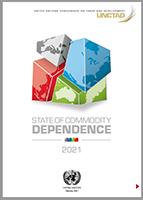
A country is considered to be commodity export dependent when more than 60 per cent of its total merchandise exports are composed of commodities. Given that commodity dependence can have a negative impact on a country’s economic development, it is important to monitor the evolution of such dependence in countries throughout the world.
In particular, detailed statistics on commodity dependence provide an invaluable tool for a comprehensive analysis of its causes and consequences and contribute to the policy debate about measures necessary to address it in the short and long terms.
This edition of the report includes a set of indicators on technology for each economy, reflecting the research discussed in Commodities and Development Report 2021: Escaping from the Commodity Dependence Trap Through Technology and Innovation.
The analytical chapter, chapter 1, discusses some developments in the decade since the launch of this report series and, in particular, aims to characterize the state of commodity dependence worldwide and its evolution between 2008–2009 and 2018–2019.
Chapter 2 provides the individual statistical profiles for the 195 member States of UNCTAD.
Map of the state of commodity dependence


